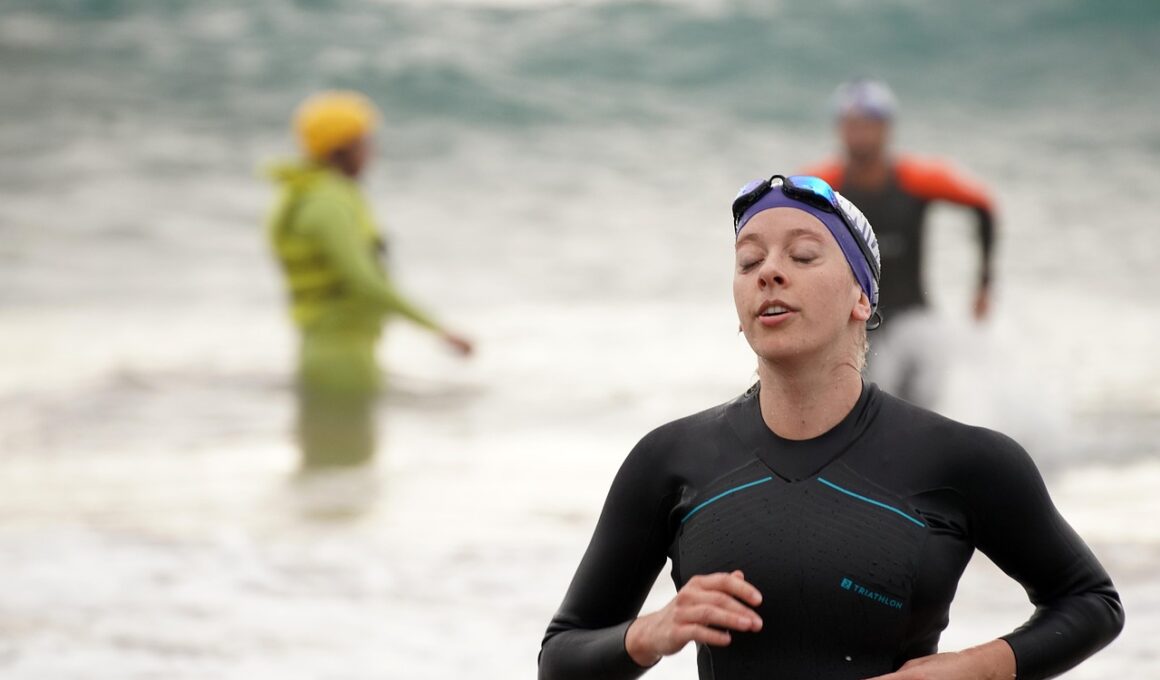Understanding the Open Water Swim Start
The open water swim start in triathlons can be a challenging phase for many athletes. Unfamiliar conditions and competitive environments often lead to anxiety and chaos. To improve your performance, it’s crucial to prepare mentally and physically. Start by familiarizing yourself with the venue before race day. Swim in the actual water, if possible, to acclimate to the temperature and type of environment. Practicing your warm-up routine in open water can also enhance comfort levels. Ensure your equipment is suited for open water swimming; a well-fitted wetsuit can provide buoyancy and warmth. Coordination with swim teammates can help establish a sense of camaraderie, easing pre-race nerves. Focus on strong communication with your coaches for tailored strategies to improve your swim start. Lastly, visualize a successful swim start, maintaining a positive mindset. This approach not only enhances your confidence but prepares you to tackle the race challenges head-on.
During the race, positioning can significantly impact your swim performance. Analyze the starting line and plan where you will place yourself among other competitors. Starting near the front may give you an advantageous position for overtaking others; however, it can also lead to a crowded and aggressive start. Instead, consider starting slightly behind the front row if you prefer a more controlled approach. This positioning allows you to navigate through the chaos more effectively. Additionally, practice your starts during training to improve speed and efficiency. Focus on explosive starts and maintaining proper form while sprinting. Experiment with different strategies to see what feels comfortable while still being competitive. Don’t underestimate the importance of a strong kick; a powerful kick can help propel you through the initial waves. Utilize sighting techniques to ensure you’re heading in the right direction without expending excessive energy. Take note of buoy markers and other landmarks to guide your course. By implementing these strategies, you can elevate your open water swim starts, ultimately improving your overall triathlon performance.
Enhancing Breathing Techniques
Mastering effective breathing techniques can significantly improve your swim performance. In open water, proper breathing patterns help maintain a steady stroke without wasting energy. Begin by practicing bilateral breathing during training; this enables you to stay balanced and adapt to the wave patterns in open water. Regular breathing intervals are essential, as they help regulate your heart rate and maintain your mental focus. Train your body to breathe every three strokes, which not only enhances your adaptability but also improves your sighting capabilities. Work on increasing your lung capacity through specific breathing exercises like diaphragmatic breathing and extended exhales. These techniques strengthen your breathing muscles, allowing for better oxygen intake during races. Additionally, consider using snorkels in training sessions; they help you concentrate on your stroke mechanics without worrying about breathing patterns. Simulating race conditions in practice will help build your comfort level with using these techniques in actual events. Consistent practice and optimization of your breathing strategies will undoubtedly lead to more efficient swim starts and a stronger overall performance.
Another crucial aspect of improving open water swim starts centers around improving your swim technique. Focusing on stroke efficiency can save valuable energy during the early competitive moments. Proper body position is fundamental; keep your head neutral and your hips high in the water. Ensure that your arms enter the water smoothly and extend fully before engaging your catch phase. An efficient kick complements your stroke; maintain a steady, relaxed flutter kick to promote speed. It’s beneficial to implement drills that target these areas during training, such as fingertip drag, catch-up drills, and breath control exercises. These drills hone technical skills while reinforcing muscle memory, crucial for race day. Further, pay attention to your recovery; an efficient recovery phase allows for a more powerful stroke entry without unnecessary splashing. Analyze videos of your swimming and seek feedback from coaches to identify potential areas of improvement. Regular practice and progressive feedback will lead to a noticeable enhancement in your technique, which will undoubtedly translate into faster swim starts and increased overall performance.
Utilizing Warm-up Strategies
Proper warm-up strategies can significantly enhance your performance before the open water swim start. Engaging in a thorough warm-up routine helps prime your body for exertion and reduces the risk of injury. Prior to the race, consider performing dynamic stretches that focus on the major muscle groups used during swimming. Arm swings and torso twists can boost flexibility and circulation quickly, improving overall cardiovascular function. Additionally, conduct short swim sets in the open water to acclimate your body to temperature variations and to feel the water’s pull. These short bursts should focus on technique rather than speed; maintain optimal form to prevent fatigue. Gradually increase your effort as the start approaches, allowing your muscles to adapt. Mindfulness practices, such as visualization and breathing exercises, can also calm pre-race nerves. Gathering with fellow competitors for supportive discussions can foster a team mentality, alleviating individual pressure. Implementing the right warm-up routine can greatly influence your confidence and physical readiness during the critical moments leading up to the swim start.
Furthermore, adapting to environmental conditions is crucial for successfully managing open water swim starts. Weather variations, tides, or waves can dramatically change a race’s dynamics, requiring effective strategizing. Monitor local weather forecasts and water conditions leading up to the race day. This knowledge allows you to prepare mentally for potential challenges. Practicing in varying conditions will not only allow you to adapt but will also boost your confidence. Familiarity with navigating choppy waters will help you remain calm when facing fluctuations during the race. Experiment with different stroke patterns or breathing techniques tailored to diverse water conditions. Maintaining focus on your race strategy despite distractions caused by the environment is essential. Consider dryland training exercises geared toward strengthening core stability and enhancing endurance. Exercises such as medicine ball throws and resistance training will build the muscle you need to tackle adverse conditions effectively. Thus, regular adaptation tactics will not only prepare you for a variety of scenarios but can significantly improve your chances of a successful swim start in triathlons.
Post-Swim Transition Coach Plan
After completing your swim, transitioning effectively into the next leg of your triathlon is paramount. A well-structured transition plan can minimize downtime and optimize your overall performance. Identify the most efficient path from the water exit to your bike, considering the transition zone layout and your position in it. Practice your transition routine repeatedly in a race-like scenario, ensuring every action is swift and purposeful. Start by quickly stripping off your wet suit and adjusting your gear, ensuring it’s easily accessible. During training, focus on reducing the time it takes to change from swim to bike attire. Conditioning your body to switch gears efficiently requires numerous practice sessions. Additionally, consider sticking to a specific order of tasks to facilitate consistency and reduce transitions. Ensure you have basic nutrition or hydration readily available, as replenishing after the swim can aid in keeping your energy levels up. By organizing and practicing the post-swim transition plan meticulously, you enhance your competitive edge in triathlon events.
Lastly, mental preparation is a fundamental strategy to improve your open water swim starts. Anxiety surrounding swim starts can hinder your performance and overall enjoyment of triathlons. To conquer pre-race jitters, incorporate techniques such as visualization, meditation, and positive affirmations into your training regimen. Daily visualization exercises, imagining your swim start success, can condition your mind for victory. Practice mindfulness to remain present; this can improve focus during the chaotic swim start. Breathing exercises can stimulate relaxation before the race, allowing your body to settle in. Furthermore, mental rehearsals—mentally going through your swim start strategies—create familiarity that can ease anxiety. On race day, develop a routine that reinforces your mental state and cultivates a positive mindset. Engage in supportive conversations with fellow competitors and coaches to boost confidence. This mental foundation is key to overcoming obstacles during the race. By focusing on mental preparedness as a vital component in your overall strategy, you increase your chances of achieving a positive swim start experience during triathlons.


